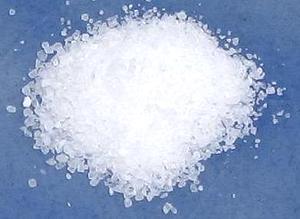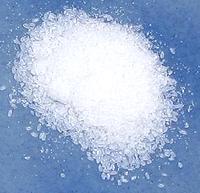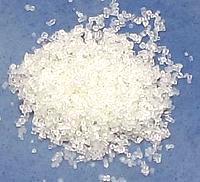Curing Salts

We no longer have to kill all our animals in the Autumn because we can't
feed them through the winter. That, along with modern transport and
refrigeration, makes the need to preserve meats for winter consumption
much less urgent. the flavors of preserved meat products, however, are
still found very desirable.
The main preservative used for meat is salt, but just salt has been
found wanting. The resulting meat is an unattractive gray-brown color,
and salt alone is insufficient to prevent infection by some dangerous
micro-organisms. It was found, however, that a little potassium nitrate
mixed with the salt resulted in an attractive pink color, helped prevent
bacterial contamination, particularly by botulism, improved flavor and
texture, and prevented rancidity.
Today a number of mixes of salt and potassium or sodium nitrate and/or
nitrite are used by both home preservers and the food industry. Some
health advocates hold that these should not be used, but actual risk
analysis has concluded that the risk from these compounds being in the
meat is much smaller than the risk from them not being there.
The most obvious result of nitrate / nitrite cures is in meat color.
Nitrates have no direct effect on color, but bacteria convert nitrate
to nitrite which does. This is why nitrite is faster acting. There is a
further bacterial action that converts nitrite to nitric oxide, which,
combining with myoglobin in the meat, is responsible for the attractive
pink color.
Salt:
 Unlike a natural salt pickle of vegetables,
sea salt is not essential for curing meat. You may use it, regular table
salt or non-iodized table salt as you please. Kosher salt can be used with
the appropriate adjustment of volume, depending on brand.
Unlike a natural salt pickle of vegetables,
sea salt is not essential for curing meat. You may use it, regular table
salt or non-iodized table salt as you please. Kosher salt can be used with
the appropriate adjustment of volume, depending on brand.
Saltpeter:
 This may be Potassium Nitrate or Sodium Nitrate. In the food industry
these have been largely replaced by Sodium and Potassium nitrite or a
mix of nitrite and nitrate (see Prague Powders, below). Nitrite is faster
acting than nitrate and less is required. Actually, Nitrate breaks down
into Nitrite during the curing process.
This may be Potassium Nitrate or Sodium Nitrate. In the food industry
these have been largely replaced by Sodium and Potassium nitrite or a
mix of nitrite and nitrate (see Prague Powders, below). Nitrite is faster
acting than nitrate and less is required. Actually, Nitrate breaks down
into Nitrite during the curing process.
I use Potassium Nitrate in wet pickling meats, such as pig feet, where
quantities are easily controlled. 0.16 to 0.20 teaspoon (less than 1/4
teaspoon) of nitrate to a quart of water, along with 2 Tablespoons of
regular salt is a fairly normal brine concentration.
USDA regulations allow up to 2.75 ounces of sodium or potassium
nitrate per 100 pounds of chopped meat, or 0.25 ounces of sodium or
potassium nitrite.
Prague Powder #1:
 Also known as Instacure #1, this is a mix of 6.25% Sodium Nitrite and
93.75% Salt. Some color, usually red dye #3, is added to give it a
tint (intensity varies with manufacturer). The purpose here is safety -
the nitrite is very dilute and easy to measure accurately, and it's
recognizable by color. The "Insta cure" name refers to the faster
action of nitrite over nitrate.
Also known as Instacure #1, this is a mix of 6.25% Sodium Nitrite and
93.75% Salt. Some color, usually red dye #3, is added to give it a
tint (intensity varies with manufacturer). The purpose here is safety -
the nitrite is very dilute and easy to measure accurately, and it's
recognizable by color. The "Insta cure" name refers to the faster
action of nitrite over nitrate.
Prague Powder #1 is used for curing meats that remain fairly wet and
are cooked before serving. Bacon and sausages are examples. About 2
teaspoons is sufficient to cure 10 pounds of chopped meat and is mixed
directly into the meat.
Prague Powder #2:
 Also known as Instacure #2, this is a mix of 6.25% Sodium Nitrite,
1% Sodium Nitrate and 92.75% Salt. Some color, usually red dye #3, is
added to give it a tint (intensity varies with manufacturer). The
purpose here is safety - the nitrite is very dilute and easy to measure
accurately, and it's recognizable by color. The "Insta cure" name refers
to the faster action of nitrite over nitrate.
Also known as Instacure #2, this is a mix of 6.25% Sodium Nitrite,
1% Sodium Nitrate and 92.75% Salt. Some color, usually red dye #3, is
added to give it a tint (intensity varies with manufacturer). The
purpose here is safety - the nitrite is very dilute and easy to measure
accurately, and it's recognizable by color. The "Insta cure" name refers
to the faster action of nitrite over nitrate.
Prague Powder #2 is used for curing meats that are air dried for a long
time. The Nitrite is fast acting and the Nitrate is like a time release
medication, acting over an extended period. About 2 teaspoons is
sufficient to cure 10 pounds of chopped meat and is mixed directly into
the meat.
Health & Safety:
 Sodium and Potassium nitrates are dangerous chemicals, powerful oxidizers
used in gunpowder and rocket fuel, but their main risk in the kitchen is
being mistaken for regular salt. In the quantities regular salt is used,
both nitrates and nitrites can kill. You must see that they are
properly contained, labeled and will not fall into unauthorized hands.
Sodium and Potassium nitrates are dangerous chemicals, powerful oxidizers
used in gunpowder and rocket fuel, but their main risk in the kitchen is
being mistaken for regular salt. In the quantities regular salt is used,
both nitrates and nitrites can kill. You must see that they are
properly contained, labeled and will not fall into unauthorized hands.
Nitrates are naturally found in many vegetables at much higher
concentrations than in cured meats, particularly in spinach, beets,
radishes, celery, and cabbages. Most reports of nitrate poisoning are
from vegetables, not cured meat. Nitrate is converted to nitrite in
the stomach.
No, Saltepeter will not make your pecker go flat - that's just a
boarding school myth - but English gin works for that. Adding nitrate
directly to food would be dangerous in any case. The trick of avoiding
any cafeteria food that's white wouldn't work anyway - saltpeter would
be dissolved, clear and invisible regardless of color.
There have been concerns about nitrosamines, formed from nitrites
during cooking or in the stomach. Nitrosamines are known to be
carcenogenic, but no actual evidence of risks to humans has been found.
Nitrosamines will form in bacon at temperatures of 350°F/157°C
and above. The FDA requires addition of ascorbic acid (vitamin C) or
sodium erythorbate to products likely to be cooked at high temperatures
which greatly reduces formation of nitrosamines. There is no reliable
information about formation of nitrosamines in the stomach.
No carcinogenic effect resulting directly from nitrate or nitrite has
been found. To achieve a fatal level of nitrites you'd theoretically have
to eat, at a minimum, 18 pounds of cured meat at a single sitting, but in
practice, due to digestive activity, it would likely take more than 50
pounds - meanwhile, you would either explode or the salt would kill you.
sa_saltpz 120820 - www.clovegarden.com
© 2009 Andrew Grygus - agryg@clovegarden.com -
Photos on this page not otherwise credited are ©
cg1 - Linking to and non-commercial
use of this page permitted
 Also known as Instacure #2, this is a mix of 6.25% Sodium Nitrite,
1% Sodium Nitrate and 92.75% Salt. Some color, usually red dye #3, is
added to give it a tint (intensity varies with manufacturer). The
purpose here is safety - the nitrite is very dilute and easy to measure
accurately, and it's recognizable by color. The "Insta cure" name refers
to the faster action of nitrite over nitrate.
Also known as Instacure #2, this is a mix of 6.25% Sodium Nitrite,
1% Sodium Nitrate and 92.75% Salt. Some color, usually red dye #3, is
added to give it a tint (intensity varies with manufacturer). The
purpose here is safety - the nitrite is very dilute and easy to measure
accurately, and it's recognizable by color. The "Insta cure" name refers
to the faster action of nitrite over nitrate.

 Unlike a natural salt pickle of vegetables,
sea salt is not essential for curing meat. You may use it, regular table
salt or non-iodized table salt as you please. Kosher salt can be used with
the appropriate adjustment of volume, depending on brand.
Unlike a natural salt pickle of vegetables,
sea salt is not essential for curing meat. You may use it, regular table
salt or non-iodized table salt as you please. Kosher salt can be used with
the appropriate adjustment of volume, depending on brand.
 This may be Potassium Nitrate or Sodium Nitrate. In the food industry
these have been largely replaced by Sodium and Potassium nitrite or a
mix of nitrite and nitrate (see Prague Powders, below). Nitrite is faster
acting than nitrate and less is required. Actually, Nitrate breaks down
into Nitrite during the curing process.
This may be Potassium Nitrate or Sodium Nitrate. In the food industry
these have been largely replaced by Sodium and Potassium nitrite or a
mix of nitrite and nitrate (see Prague Powders, below). Nitrite is faster
acting than nitrate and less is required. Actually, Nitrate breaks down
into Nitrite during the curing process.
 Also known as Instacure #1, this is a mix of 6.25% Sodium Nitrite and
93.75% Salt. Some color, usually red dye #3, is added to give it a
tint (intensity varies with manufacturer). The purpose here is safety -
the nitrite is very dilute and easy to measure accurately, and it's
recognizable by color. The "Insta cure" name refers to the faster
action of nitrite over nitrate.
Also known as Instacure #1, this is a mix of 6.25% Sodium Nitrite and
93.75% Salt. Some color, usually red dye #3, is added to give it a
tint (intensity varies with manufacturer). The purpose here is safety -
the nitrite is very dilute and easy to measure accurately, and it's
recognizable by color. The "Insta cure" name refers to the faster
action of nitrite over nitrate.
 Sodium and Potassium nitrates are dangerous chemicals, powerful oxidizers
used in gunpowder and rocket fuel, but their main risk in the kitchen is
being mistaken for regular salt. In the quantities regular salt is used,
both nitrates and nitrites can kill. You must see that they are
properly contained, labeled and will not fall into unauthorized hands.
Sodium and Potassium nitrates are dangerous chemicals, powerful oxidizers
used in gunpowder and rocket fuel, but their main risk in the kitchen is
being mistaken for regular salt. In the quantities regular salt is used,
both nitrates and nitrites can kill. You must see that they are
properly contained, labeled and will not fall into unauthorized hands.